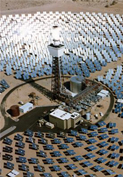
Tower of power
Solar Two, built near Barstow, used molten salt to capture and store the sun's heat. The very hot salt was stored and used to produce steam to drive a turbine/generator that produced electricity.
Solar Technologies
Of the 54 right-of-way applications the BLM is currently reviewing for approval, roughly 60 percent call for the use of concentrated solar power (CSP), also referred to as solar thermal power, and the other 40 percent propose the use of photovoltaic (PV) technology.1
There are three main types of CSP technologies:
- Parabolic trough
- Power tower
- Dish/engine
There are three main types of PV technologies:
- Flat plate
- Thin film
- Concentrating PV
Developers consider these six technologies when scoping a utility-scale solar project. These systems are ideal for bulk electricity generation because they are designed to produce power on a utility scale, which is orders of magnitude greater than distributed generation or rooftop systems. While there is currently no set definition of utility-scale solar, these facilities generally have a nameplate capacity of over 50 MW and produce electricity that is fed back into the electric grid. In order to generate this amount of power, utility-scale solar power plants require large parcels of land along with access to either surface or groundwater, especially if the facility has an associated cooling system.
A value called the capacity factor is used to describe the overall efficiency of a power generation facility. The capacity factor is defined as the ratio between the actual output of a power plant and the maximum rated output, or nameplate capacity. It is calculated by measuring the total energy produced over a period of time and dividing by the amount of energy the plant would have produced over the same period of time at full capacity. For CSP and PV plants, the capacity factor is dependent primarily on the availability of the sun’s energy over a given period.
1 U.S. Department of the Interior, Bureau of Land Management, Solar Energy Projects Application Table Summary, http://www.blm.gov/ca/st/en/fo/cdd/alternative_energy/SolarEnergy.html.
